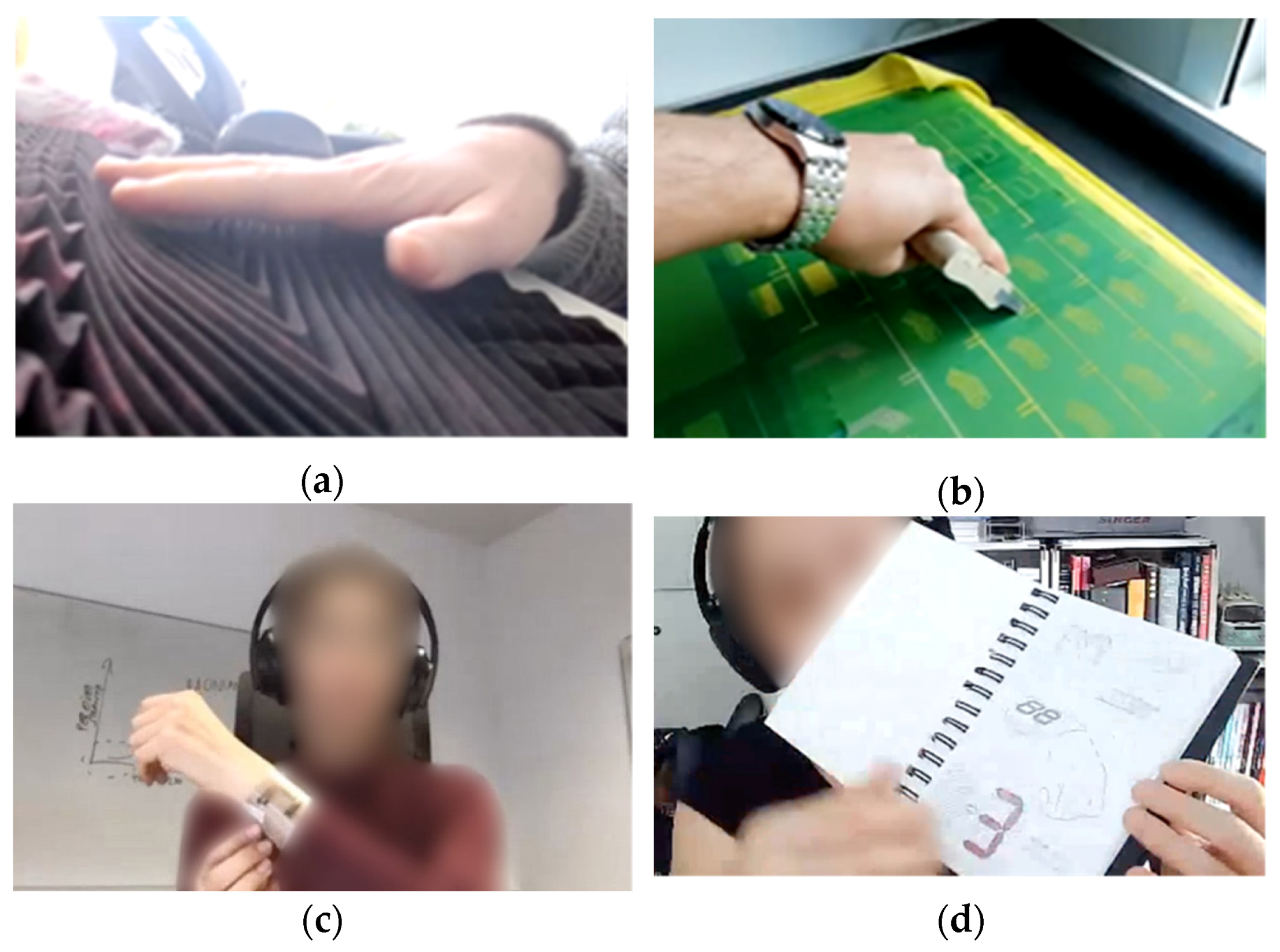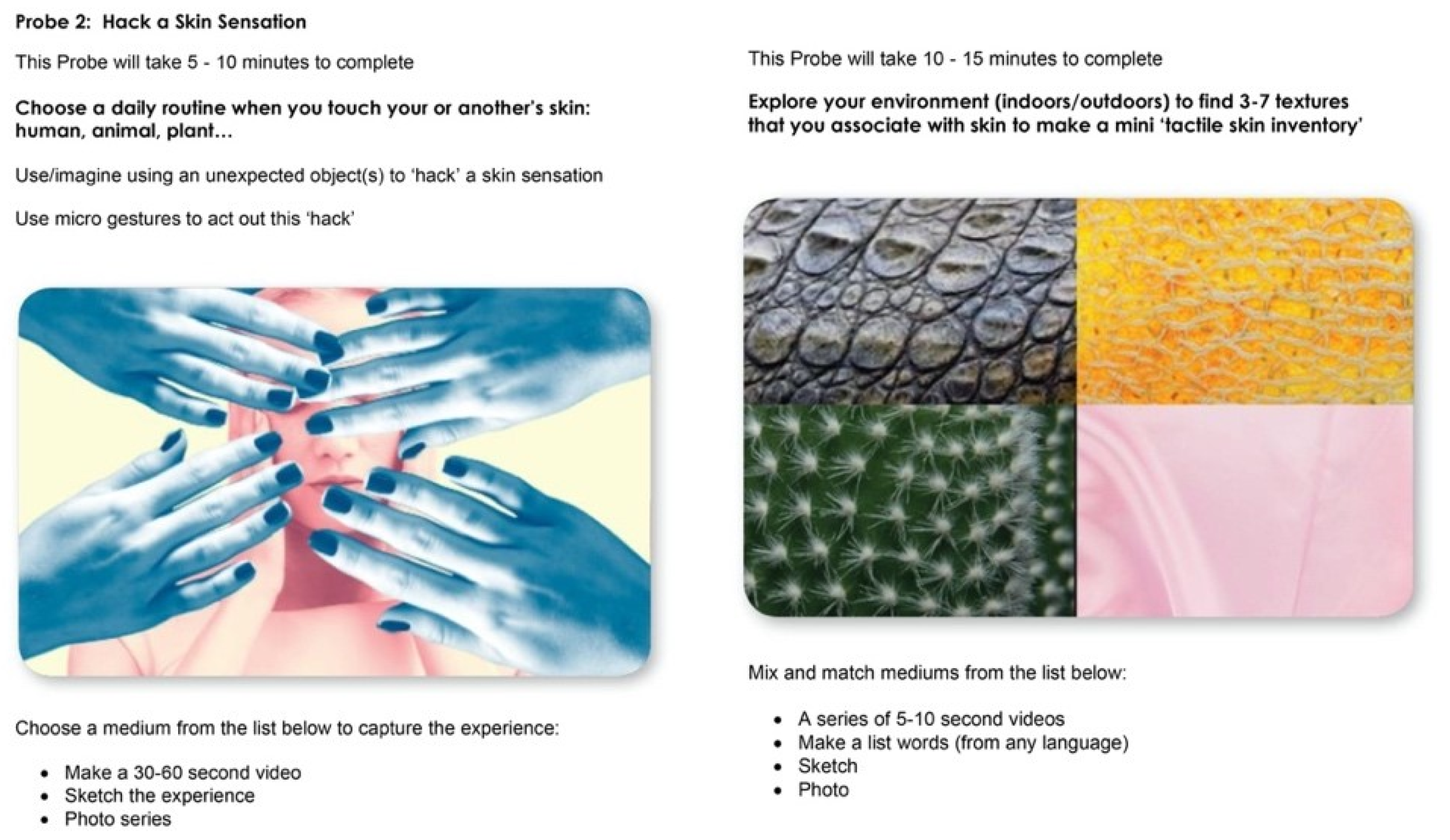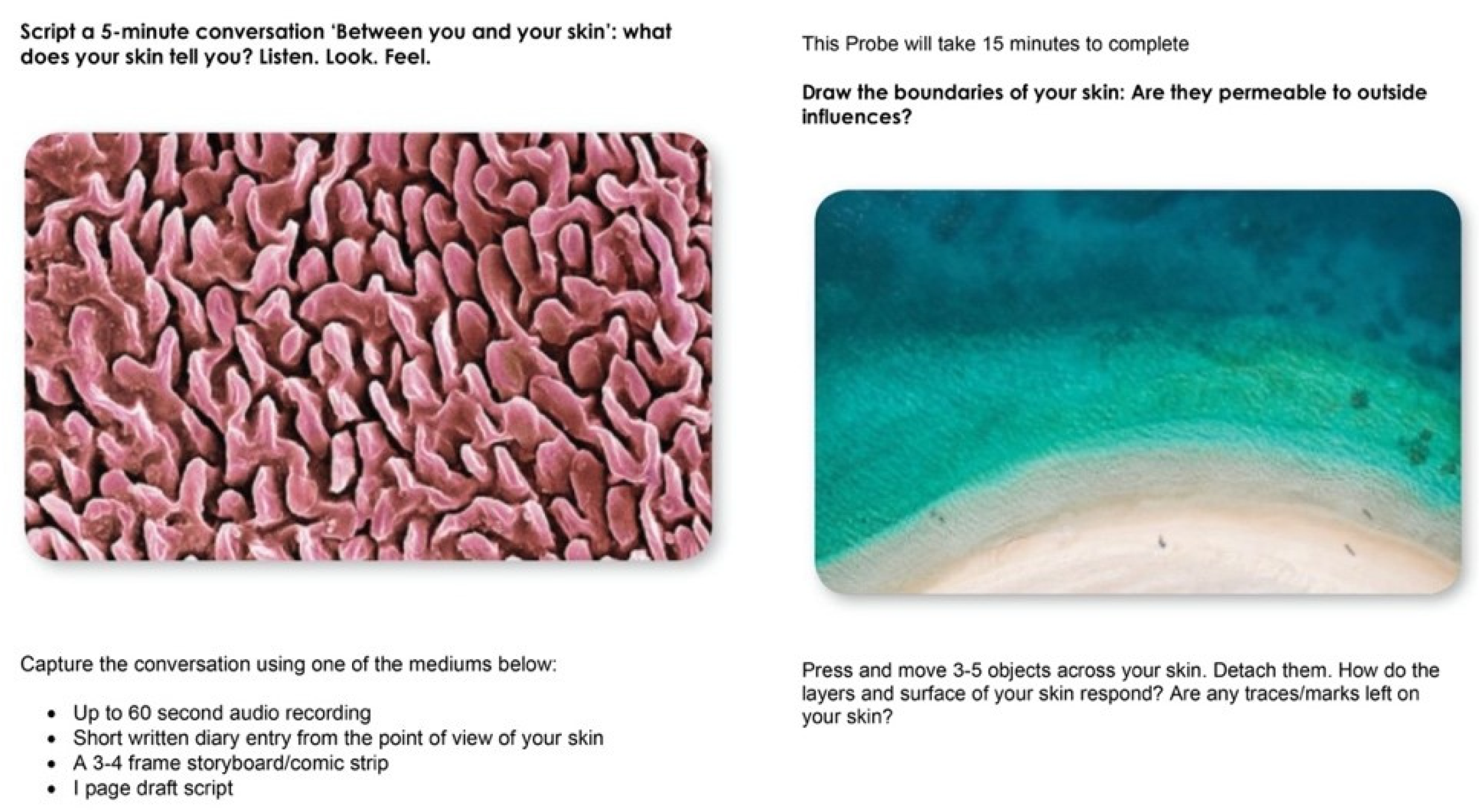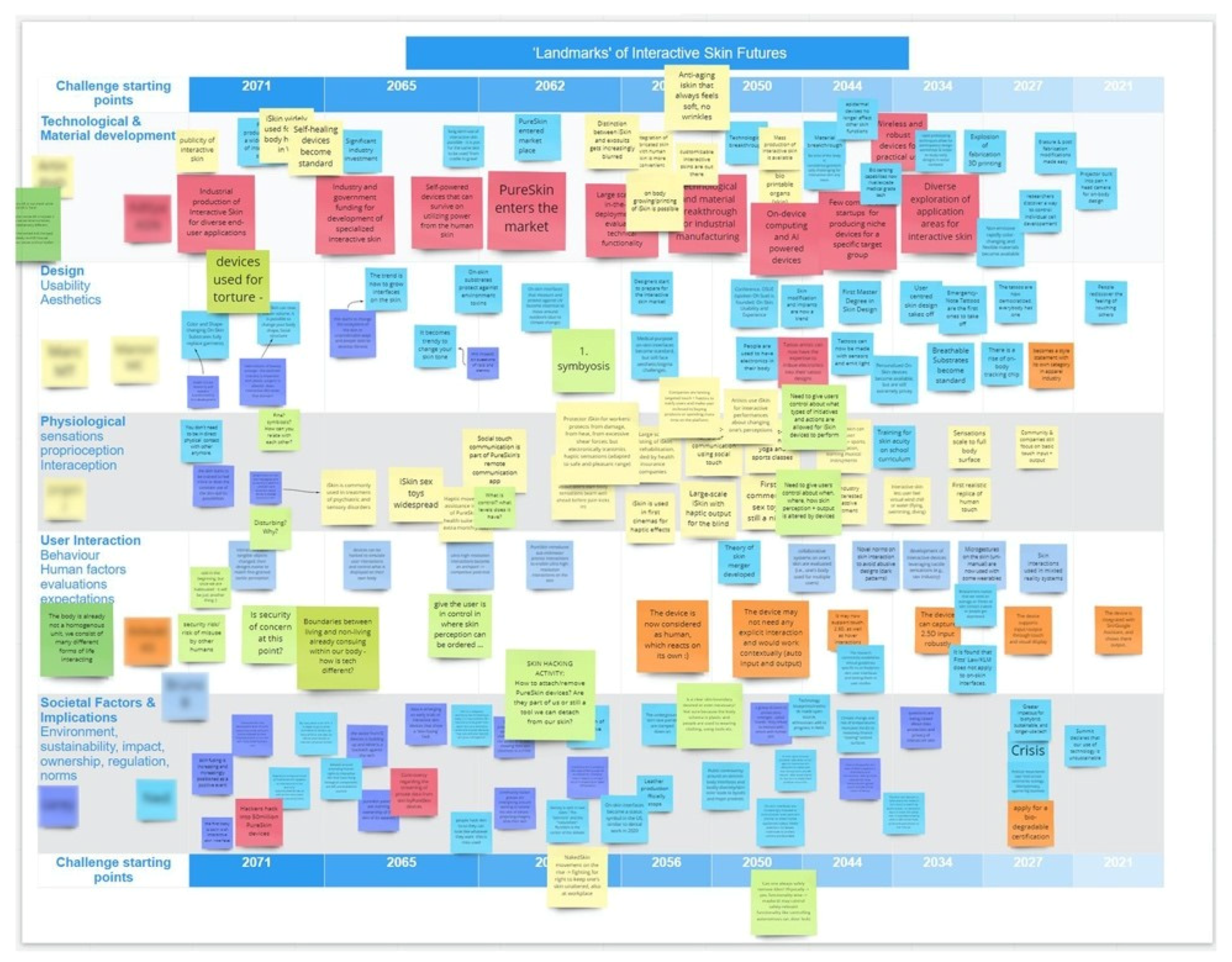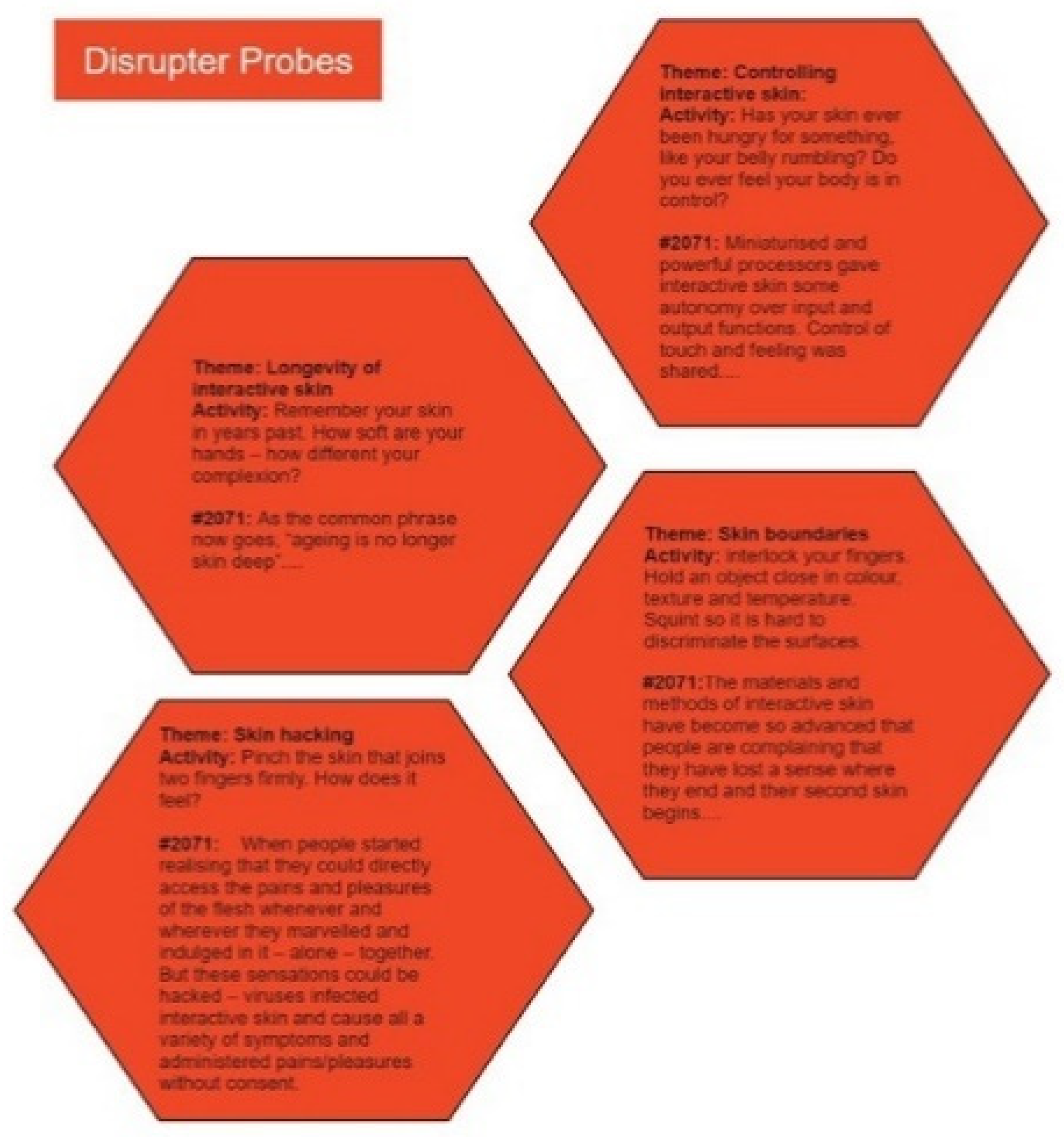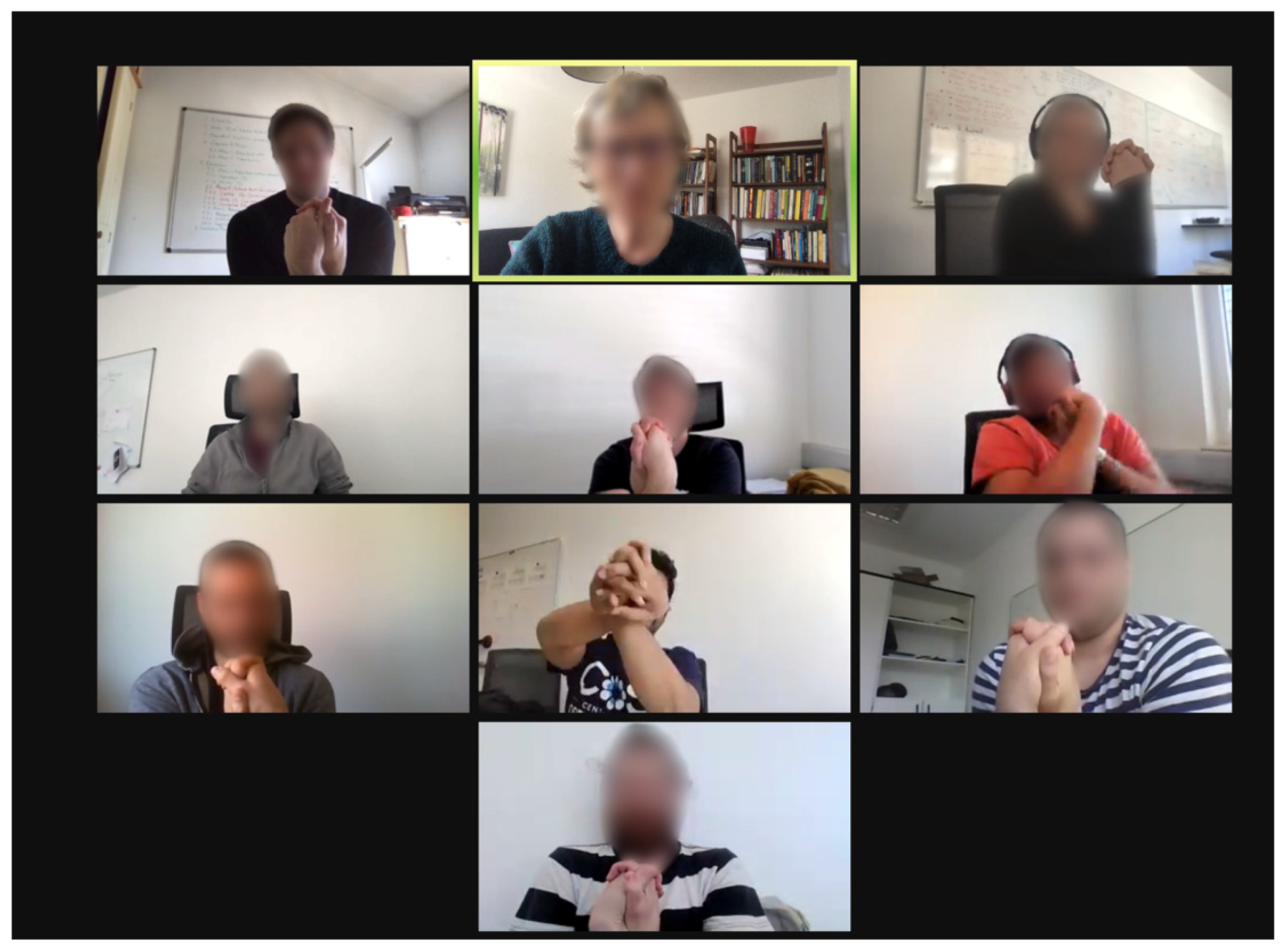3.1. Introduction
The interactive skin case study aimed to better understand the social and sensory implications and potentials of interactive skin. The case study sought to describe the social, sensory and semiotic aspects of interactive skin and its design; and to offer socially orientated critique to inform future designs of interactive skin. In addition, in response to researching during the COVID-19 pandemic, the study set out to contribute to remote sensory research methods. The case study was conducted in an HCI lab consisting of researchers with backgrounds in computer science, HCI, design and engineering. The lab was selected as it is a central node in the field of interactive skin (i.e., connected to other international research labs via researcher mobility and projects). The study participants were HCI researchers rather than end users of interactive skin technologies in order to focus on the professionals engaged in the ongoing production of emergent digital devices. Our rational for selecting these participants was to capture a range of disciplines and experiences as a lens through which to construct overarching sociotechnical imaginaries of interactive skin. The lab was recruited via an initial meeting with the lab leader, where we outlined the case study. The invitation to participate was extended to the (seven) lab members working on interactive skin. Participation was voluntary and a process of informed consent was undertaken, with an information sheet and a consent form sent prior to the start of the study. All lab members (eight in total) agreed to participate. Their specialisms and foci included technical work on the development of sensors and materials (3), skin-based design techniques (2), haptics and interaction design (2), critical and speculative design (2), and the social acceptability of interactive skin (1).
A novel three-phased approach was developed to foreground the social and sensorial aspects of the relationship between body and technology in novel creative ways. The decision to move the study online due to COVID-19 restrictions impacted the approach as it changed the possibilities for interaction (e.g., casual hanging out and ‘being there’ afforded by the originally planned physical visit); however, it also stretched the process of engagement from a one week visit to a one month encounter with the team. This allowed us to introduce the skin study concepts across a series of research encounters and for these to be cumulatively ‘fleshed out’ through activities. The shift to online research also raised challenges for the use of sensory methods and required the case study methods to be adapted (outlined below). The three-phase approach places creative methods within a multimodal [
13] and sensory [
16] frame, which share a qualitative attention to meaning beyond language, bodily interaction and the felt [
37], and attend to participants’ first-person perspective on the sensing-touching body, and the technological and material constraints that shape experiences. The approach focused explicitly on the sensory and the social through creative, reflective and empathetic methods of attuning to one’s own experiences, which both compliments and distinguishes it from user-centred design methods used within the lab and HCI more generally. The three phases of the approach are outlined below.
3.2. Phase 1: Grounding
This initial phase mapped the participants’ conceptualisation of interactive skin including their use of working concepts, vocabularies and research methods, and their projects. The visual limitations of being online meant we had to gain other entry points into their practices and ways to bring in touch and the body more generally.
Research literature: Participants were invited to review and add to a shared online folder containing their papers and biographical information (i.e., research themes and interests, projects, collaborators, disciplinary training/background, and languages spoken). A review of this provided a sense of the key themes across the team, differences between participants and networks within the team.
Lab tour: Using Zoom on his mobile phone, a participant took the authors on a real-time (1 h) guided video walk tour of the lab rooms and facilities. He detailed the purpose and use of various machinery, technology and materials in lab spaces. He chose where to take us and what to show by directing his phone camera (‘our eyes’). As this fieldnote excerpt suggests, the tour experience was different to ‘being there’: “I found it hard to interrupt not wanted to break interesting descriptions, finding a gap/appropriate time, not being rude: this is very different to the subtle cues that you can do while present”. To expand the sensory possibilities of the tour, throughout, we asked our participant guide to describe and demonstrate the texture of materials (e.g., the viscosity of inks), manipulate (e.g., stretch or drape) materials, demonstrate the use of devices (e.g., how they are held); and at times, we asked him to bring materials or objects closer to the screen. In this way, the tour became an immersive sensory experience, albeit one constructed through the eye of a camera and the feel of another, and without the serendipity of ‘being there’, noticing and touching, smelling a process, asking what is behind a door or engaging with a passer-by. Nonetheless, the tour contributed to our understanding of the sensory and technical environment involved in the production interactive skin.
Sensory interviews: In-depth sensory interviews were conducted with each participant on Zoom. Interviews were between 49 and 65 min (excluding introductions), an average of 55 min, and a total of 6 h and 20 min of interview data was collected. Interviews used an open topic guide focused on understanding how participants approach the skin in their research and if/how they engage with the social and sensory aspects of skin/interactive skin. Topics included ‘unpacking’ key research/design themes, reflections on design goals, and aspects of the social use of interactive skin (e.g., intentions, body location, users, and ethics). The interviews used objects as tactile sensory probes to help participants recall, ‘flesh out’, and ‘reconnect’ with the skin, touch and the body. This experiential method draws on the notion of sensorial empathetic research encounters with a participant’s sensory world to explore their experiential experiences [
16].
We interviewed participants in a place where they had access to significant objects and materials related to their current work (e.g., prototypes or props)—this varied between home, studio, and lab. Participants were asked to use these objects as material prompts to think through or to demonstrate an idea or process during the interview to help elaborate on the discussion. Our reflections on their use in the online Zoom environment shaped how we brought these objects into the interviews and evolved over time.
Participants interacted with these sensory touch objects (
Figure 1) intuitively and occasionally in response to the interviewer’s prompting. They used them to demonstrate or re-enact an experience or process or to illustrate a tactile feature (e.g., thinness and flexibility), concepts (e.g., social acceptance and skin markers) or ideas (e.g., manipulating objects to show how the body interprets and categorises sensation). While the visual display of tactile interaction afforded by Zoom and the empathetic character of sensory research encounters offered a relatively weak pathway to participants sensory experiences, we sought to strengthen this by introducing the method of ‘proxy feelers’. The ‘proxy feelers’ method was developed in the larger InTouch project, initially in response to the difficulty participants experienced in articulating their touch experience in a case study of virtual touch [
38], and later through a case study exploring robotic touch where the approach was tested and refined for remote (online) interview contexts to manage the tactile paucity of online research encounters [
39]. The method consists of a three-part process. First, participants are invited to Demonstrate an idea/action and the interviewer mimics these using a proxy material to generate questions on the experience. Second, participants are invited to Feel the object while the interviewer probes to gain a sense of touch that extends beyond texture and cutaneous sensations to the social and sensorial. Third, participants are asked to Disrupt the function of the object they are handling or to suggest a usage that would alter or disrupt it. The following prompts for ‘proxy feelers’, for example, were used when asking participants to reflect on their consideration of the body placement of an interactive skin device: (1) Demonstration: Where would you think of placing it on yourself? Can you hold it against that part of your body? How visible/hidden is it? (2) Feel: How does it feel to have it there on your body? How might that feel during the scenario you have designed for? How do you imagine your intended user feeling? (3) Disruption: How do you imagine [chose a different context/person] would feel? The interviewers used props (e.g., cling film, stretchy materials and objects at hand) in mimicking participants’ actions through the ‘demonstrate, feel and disrupt’ process to prolong and probe the social and sensory aspects of their interactions. Participants found this approach powerful and useful:
“I’ve had these materials in my hands several times. But not in a way where I really carefully concentrated on what happens when I am feeling… [in my project] I was thinking more about the technical properties of the materials that I want to use, but now consider the appearance or the feeling that we get from these materials that we are using”.
(P8)
Participants were keen to bring their objects/materials into the interview although they sometimes found it hard to introduce them. Initially, we also found it difficult to bring these materials in ‘naturally’ and our mimicking movements confused and distracted some of the participants who thought the interviewer was trying to signal something or interrupt. In response to this shared difficulty, we introduced a brief explanation of the use of objects, materials and this ‘empathetic’ method in the interview, and we sought to bring our and participants’ objects as early as possible, and explicitly negotiated this process with participants.
Discussion Phase 1
A preliminary thematic analysis of Phase 1 materials was undertaken and a set of emerging working themes were developed to capture the participants’ collective inspirations (e.g., wearable technologies, synthetic materials, and science-fiction narratives), vocabularies and concepts (e.g., social acceptance), and practices (e.g., tattooing, low-fidelity on-skin prototyping and critical design). Emergent themes included the technology constraints and possibilities (e.g., sensor design); the ‘skin as a boundary’ between technology and human as an ethical line not to be broken; visibility—discreet, detachable, and unobtrusive devices and interactions; skin hacking and augmentation; the compatibility of interactive skin with the organic and natural; connectivity and connection; body ‘landmarks’ and the location of interactive skin devices; tactile aesthetics; materiality (e.g., durability); and the care of skin/interactive skin. These working themes informed the development of the ‘interactive skin probe pack’ (Phase 2) and the starting points for the speculative workshop (Phase 3). They also pointed to the potential of creative research methods for exploring the relationship between body and technology.
3.3. Phase 2: Probing
This phase centred on the development and launch of the interactive skin probe pack. A set of seven creative probes (or tasks) were designed as a provocative research tool to facilitate participants (and researchers) to explore the social and sensory aspects of the skin in novel creative ways to open new spaces for research/design and to gain an impressionistic account of participants’ associations and beliefs, social and cultural concerns, and to probe the past and present to re-imagine the future [
22]. To do this, the probe pack was designed to bring Phase 1 emergent themes (primarily from HCI/design) into conversation with key concepts from skin studies (a subfield of body studies which brings the body’s surface into focus). Skin studies are informed by a transdisciplinary approach drawing on a social science and humanities perspectives as well as critical race studies, gender and sexuality studies, and sensory studies [
40]. Both these perspectives, albeit differently, engage with skin in terms of its temperature and durability, its many felt properties (e.g., soft, reactive, hard, conductive, stretchy, thin, thick and layered) and its malleable, adaptable and flexible character. The rich vocabulary of the skin and five critical concepts from skin studies (introduced below) provided potential points of connection with interactive skin research (based in HCI).
3.3.1. Five Critical Bridging Concepts
Skin as a boundary: Skin studies ask how the skin is conceptualised and what social meanings this achieves. Thinking of the skin as a boundary is seen as a central construction of the skin/body: the skin is ‘the ultimate boundary organ … a cultural border between self and world… where subjects can encounter each other’ [
41]. From this perspective, the skin is an ‘ecology’ through which the notion of, and relations with the self, other and society are shaped [
40]. The skin as a boundary and its breaking are also understood as underpinning skin practices (e.g., tattooing and piercing) and fantasies of penetrating or removing the skin. Skin studies seek to critically rethink the skin to breakdown the conceptualisation of the skin as inside/outside, surface/depth and self/other [
42]. These notions of skin as a boundary speak to the place of interactive skin at the interface of the body and technology.
Skin as living, fluid and in flux: Skin studies and interactive skin research both engage with the skin as a living and changing organ. Lafrance argues that the skin is both permanent and temporary, delicate and resilient and is ‘…always already in flux. It is a fluid boundary and a leaky interface. It is configured and reconfigured through affective relations, sensory transactions and social interactions’ [
40]. This concept connects interactive skin design’s consideration of the biological and physical processes of the skin in relation to environmental change, with skin studies’ exploration of the experiential, social and biological ever-changing dynamics of skin.
Augment, modify, hack the skin: The practices of modification, augmentation and hacking offer a connection between interactive skin research and design practices, and skin studies’ interest in skin practices (e.g., implants and cosmetic surgery). Skin studies explore the relationship between the skin, body and technology and argue that as technology enables us to modify our skins more than ever, to ‘cross skins, merging with other bodies or colonizing multiple bodies’ [
43], the skin is increasingly bound by a collective sociotechnical imaginary that modifies the surfaces of our bodies in transformative ways. The study participants and interactive skin more generally engage with the concepts of augmentation and hacking through a focus on body adornment and tattoos.
Skinscape and skin markers: The concept of ‘skinscape’ refers to the ‘contiguity or intimate association between the surface of the body and the surface of the earth or landscape’ [
44]. This conceptualisation of the skin beyond the individual reconfigures the skin as social, an interface and as ‘knowledgeable or sentient’ [
44]. Here, the skin is understood as ‘an archive of past experiences, a cartography of identity’ [
40], our social and personal histories made visible by ‘skin markers’ from everyday pain (e.g., blisters and scars [
43]), intimate experiences, to our ‘public raced, sexed and national histories’ [
42]. These concepts connect with interactive skin research/design through questions of how it might connect a wearer to another person or the environment, augment the skin as a social interface, draw knowledge from the skin, store (archive) data or make a wearer’s emotions newly visible or felt.
Skin as a project: The term skin projects (e.g., grooming, bleaching, tattooing, and cosmetic ‘plastic’ surgery [
40]) is an extension of how people attend to their bodies as projects in ways that both reflect and reproduce sociocultural structures [
45]. This concept points to how the body’s surface embodies tensions in consumer culture and how the visual displays and appearance of skin work to sell a process or the ‘commodification of skin’ [
46]. Interactive skin can be understood as a digital skin project.
These five critical bridging concepts offered points of connection between the social, sensory and technological aspects of interactive/skin.
3.3.2. The Interactive Skin Probe Pack
The interactive skin probe pack sought to attune participants to the social and sensory aspects of skin and its remediation via interactive skin technologies. Phase 1 insights and the critical skin study concepts (outlined above) provided a creative springboard for the design of seven probes. The probe names are listed below and mapped to the critical skin study concepts in
Table 1.
Each probe features a short creative task that invited participants to engage with and reflect on the skin alongside an evocative image (see
Figure 2). The probes were designed to be provocative, playful, open-ended and ambiguous, and enjoyable to complete. Some probes included exploratory experiential tasks focused on doing and describing; these included instructions of how or what to touch, and invited participants to generate a critical reflective response. Probe 2, Hack a Skin Sensation, for example, invited participants to ‘
Choose a daily routine when you touch your or another’s skin: human, animal, plant… Use/imagine using an unexpected object(s) to ‘hack’ a skin sensation; and use micro gestures to act out this ‘hack’. Other probes consisted of questions to respond to, for example, Probe 6,
Boundaries, asked participants to ‘
Draw the boundaries of your skin: Are they permeable to outside influences?’ Others suggested tactile sensations to experience, or concepts or images to respond to. Probe 4, Living Skin, for example, included an image of the skin and invited participants to ‘
Script a 5-min conversation ‘Between you and your skin’: what does your skin tell you? Listen. Look. Feel.’ The format of the probe responses varied with optional forms including short videos, written notes, narratives, audio notes, sketches or photographs. These formats also drew on the participants’ preferred or specialist practices identified during phase 1 (e.g., enacting micro gestures and sketching).
The probe pack was ‘launched’ in an (online) meeting with participants as a group. A short presentation explained the use of probes, what to expect and the time commitment. Participants were invited to take an informal approach to the materials, and it was emphasised that there was no right or wrong response. The launch included time for questions and answers. The probe pack was emailed to participants following the launch meeting.
All participants were invited to complete Probe 1 and to choose one or two optional probes (from Probes 2–7) to complete by the end of the week. Probe 1 (Skin Attunement) consists of a series of five (5 min) daily activities, one emailed to participants daily for two reasons: first, to bring a routine/rhythm to the attunement tasks as a daily practice designed to encounter skin/touch differently through everyday experiences; second, to provide a sense of surprise to elicit creative responses and avoid participants overthinking the probes. Probe 1 provided participants a collective experience of attunement to the skin. Probe returns were returned to the researchers and participants were asked to share only what they were comfortable with sharing. Participants reported sharing some of their probe experiences and responses with some of the other participants. The probes thus prompted new conversations between participants and researchers and among the participants.
Most participants completed the probe tasks as requested (see
Table 2); however, P1 did not complete all Probe 1 daily tasks and P5 returned only one probe due to illness and workload (they participated in the other activities). Optional Probe 5: Skin Landscapes and Probe 7: Skin Postcards were not selected by any participant (on reflection, the latter at 25 min was perhaps too long).
3.3.3. Discussion Phase 2
Phase 2 provided participants with a novel space for creative, felt explorations attuned to (interactive) skin. The participants (in exit interviews) described the probes as “exciting” “open”, “fun”, “enjoyable” and “interesting” and that the probes enabled a new attunement to the skin:
“During our conversations, there were some points that came out which were implicitly present. Like my work is relative to skin ethnicity, but I didn’t notice it in that way…I think that the probes somehow expanded my horizons to think about skin parts… Everything combined together to help me think”.
(P2)
“When I go on vacation I might write some postcards to my skin”.
(P4)
The probes brought forth strong felt memories of the skin, themes of comfort (e.g., self-calming), protection, and fear (e.g., in relation to COVID-19), confirming the need to consider the ethics of probes including how they are shared. Participants commented that the probes helped to expand their notions of the skin (and touch) from a design focus on the hand/arm to the whole body and, in doing so, newly drew their attention to barriers to the skin (e.g., clothes). The probes helped to newly foster reflection on the changing character and boundaries of the skin, its textures and how this map to practices of care and body ‘maintenance’ (e.g., moisturising). They also highlighted the political, social and sensory aspects of skin experiences that they found useful. Participant comments also drew attention to their emotional and felt connection through the skin with the self, others (friends and family) objects and environments (e.g., the sun and the seasons). Several participants expressed surprise in how touching something familiar newly could reveal information or evoke memories to bring the contours of the skin newly into view. Collectively, the probe method encouraged participant exploration and engaged them with the social aspects of skin in unexpected and interesting ways. In response to Probe 5, for example, a participant (P6) improvised a script which he performed with a friend and video recorded.
The above themes (together with insights from Phase 1) were used to ground the speculative work of Phase 3 in participants’ interests in and sociotechnical imaginaries of interactive skin. More generally, the playful creative space generated through engagement with the probes provided an entry point into the work of speculating on the social/sensory aspects of (interactive) skin and exploration of the relationship between body and technology in Phase 3.
3.4. Phase 3: Speculating
Phase 3 explored the futures of interactive skin through a speculative design workshop and a closing interview. The workshop activities were designed to foster collaborative conversation between the participants and the case study researchers and to explore their sociotechnical imaginaries of interactive skin, support engagement with critical socially orientated concepts of skin, and to map the possibilities and challenges for interactive skin futures. The workshop was inspired by a speculative conference presentation [
47] (attended by one of the authors) on shape-changing interfaces in which the audience were invited to ‘
Close your eyes. Imagine you are in 2068…Shape changing interfaces are here!’. The presenters asked ‘
How did we get here?’ and counted back from 2068 to mark the landmarks that had shaped the future. When their narrative reached the present-day—then 2018—the presenters asked, ‘
Too utopian?’ and reversed tack to moving rapidly forward to 2068 to offer a more dystopian vision of shape-changing interfaces futures, and pointing to other futures that might play out between these utopic and dystopic extremes.
The interactive skin speculative workshop filtered participants’ research and design knowledge of interactive skin (gained through Phases 1 and 2) through a 50 year ‘futures timeframe’ to project interactive skin from 2021 to 2071. This timeframe and five starting points for the future projection were used to create a table on Miro, an online collaborative platform familiar to the participants. The five starting points reflected the distinct disciplinary focus or area of research interest expressed by participants (in Phase 1) (i.e., technological and material development; design usability and awareness; physiological and sensory; user interaction behaviour; societal impact, norms and regulation). Miro was used to support, share and capture participants’ responses to workshop activities. The workshop (2.5 h) consisted of two activities centred on the table followed by a group brainstorm and discussion of the social issues for interactive skin futures. During the workshop, we (authors 1 and 2) immersed in the social, sensory, and technical possibilities of interactive skin (through Phases 1 and 2), positioned ourselves as participant-facilitators and contributed to the discussions from our socially orientated perspectives.
Activity one (1 h) was grounded in a future technological starting point (a shared point of connection for participants) and invited participants to: ‘Imagine it is 2071. Interactive skin interfaces have happened: they are ubiquitous. People love them! How did we get there? Four years ago, in 2067 a large technology company developed ‘PureSkin’—a detachable, reliably conductive and digitally sophisticated wireless skin interface, which is invisible to the human eye, contours to any location on the body, and is so thin that it is barely perceptible through touch’.
The Miro table dimensions were introduced. Participants were invited to select one or more starting points and to use Miro sticky notes to follow that trajectory through time to speculate on and plot the future(s) of interactive skin. Participants worked individually and simultaneously, and our identity (represented by an icon and colour coded stickies) was visible to one another as we worked on the board. As the table was populated, participants started to interact with (e.g., build on or react against) one another’s sticky-note comments and projections. Through this process, a dynamic multifaceted collective mapping of interactive skin futures was generated (
Figure 3)
Activity two (1 h): while activity 1 brought some attention to the social, this activity sought to foreground and track how the social might manifest to disrupt, probe and stretch the futures of interactive skin and invited participants to: ‘Imagine it is 2071. The design, fabrication and use of various forms of interactive skin are ubiquitous and are being experimented with in unanticipated ways and with unintended consequences. Governments, corporations and new communities are all actively engaged in the use and monitoring the use of interactive skins. In short, interactive skin is out of the control of designers, engineers’ [i.e., out to the control of the participants].
A set of 10 ‘disruptor probes’ were introduced to the Miro board. Each probe was built around an emerging theme (from Phases 1 and 2) and consisted of two elements—first, a short social and sensory attuning activity (a movement, feeling or material), and second, a speculative provocation (
Figure 4). For example, Longevity of interactive skin:
Remember your skin in years past. How soft are your hands—how different your complexion? As the common phrase now goes, ’aging is no longer skin deep’; or Skin boundaries:
Interlock your fingers. Squint so it is hard to discriminate the two surfaces—through sight or feel. Now find an object close by a close in colour, texture and temperature to your skin. Squint again: The materials and methods of interactive skin have become so advanced that people are complaining that they have lost where they end, and their second skin begins.
The task of responding to the Disrupter Probes was introduced to participants: ‘The future is uncertain: disruptions and unexpected events and developments rain down in the form of ‘Disrupter Probes’ set to crash into the interactive skin futures you have plotted. Working as an Interactive Skin Rapid Response Team, you need to track their scattering effect across the plotted timeline: discuss, add new stickies, extend or adapt existing stickies’.
As each Disrupter Probe landed onto the board (in a specific time period), participants were required to work collectively to review the board and react. Several of the Disrupter Probes triggered participants’ use of the ‘proxy feeler’ method (demonstrate, feel and disrupt). As the
Skin boundaries Disruptive Probe dropped onto the board, for example, a participant began to act out the attuning exercise-‘
Interlock your fingers. Squint so it is hard to discriminate the two surfaces—through sight or feel. Now find an object close by a close in colour, texture and temperature to your skin. Squint again’ and the other participants joined in with this action (
Figure 5). This prompted a discussion of the materials and the boundaries of the skin and interactive skin.
Participants’ use of the Disrupter Probes led to socially orientated reflection and discussion, sedimented in an overlay of reflective stickies.
“I think that was good it showed us very interesting aspects, taking some desirable or undesirable futures, and then designing backwards from them… we lack an approach or method of working against those things that are not desirable… this is a practical way to engage engineers to take concrete steps to go somewhere or in this case avoid undesirable futures”.
(P1)
The third and final brainstorming activity (30 min) reviewed the map generated through the previous activities to explore the social challenges and possibilities for interactive skin futures. This provided an opportunity to select and refine themes exposed through the speculative workshop process, conversations that continued with participants in an exit interview to explore further what resonated with their work or agitated their thinking.
3.4.1. Exit Interview
A closing interview was conducted with each participant (online and between 30 and 45 min long). These interviews focused on eliciting participants experience of bringing the social to the fore of interactive skin, and the case study methods including exploration of if and how engaging with this approach had contributed to their design/thinking. The interview closed with participants’ Probes 1e, which asked participants to, ‘Reflect on the Probes you have done this week and write a new set of instructions for another person to attune to the skin’. The participant introduced the probe, the interviewer undertook the task and shared their response.
3.4.2. Discussion Phase 3
Participants enjoyed the workshop and found it useful:
“The speculative session worked super well, we identified a lot of material, we could write a paper on speculating what are the challenges for skin interfaces… the workshop after a creative boost this worked well, I think I am going to read this method.”.
(P6)
The workshop Miro boards were transcribed and collated to produce a series of bullet points for each time period. That was shared with the lab leader to review, comment on and rank (high–medium–low) in relation to their significance for the future of interactive skin. This underpins the development of a speculative narrative on interactive skin aimed at supporting reflection and questioning, and disrupting and extending the work engineers, designers and researchers working with interactive skin (Jewitt, Barker and Steimle, forthcoming). The narrative brings the five starting points of the workshop mapping exercise (i.e., the technological, material, design, physiological, user interaction behaviour, sensory and societal) into a 50-year temporal framing and puts them into synergetic conversation to expose the tensions and connections involved in the future of this emergent technology.
In addition, the workshop and exit interviews generated a rich collection of themes. How social practices shape our touch interaction with technology was discussed, for example, how manual practices alter skin and technology interactions (e.g., one participant noted how using a sander for extended periods resulted in his fingerprints not being recognised by his phone). The balance of beauty aesthetics vs. the functionality of interactive skin and the notion of what beautiful skin looks and feels like raised questions around the place of culture and skin. A discussion of skin longevity explored how the skin is living and future possibilities of digital skin protection (e.g., from pollutants) or having ‘younger patches’ of interactive skin were raised, alongside evolving health-care skin behaviours being altered through interactive skin (e.g., skin masking for skin tone and ageing). Participants discussed how this might reinforce or eliminate existing class, culture, racial and disability inequalities realised at least in part through the skin. The concept of body-schemas and how interactive skin may become part of or disrupt them wove across the workshop mapping. The social consequences of ‘hacking’ interactive skin devices, and specifically the close connection of these devices on the body might result in losing trust in one’s own body was explored through discussion of privacy and security (who would have access to the device?)—raising ethical questions of control and surveillance. The complex boundaries between the ‘living’ and ‘non-living’ with and within (e.g., mitochondria) our bodies led to discussion of ethics around ‘skin boarders’ as well as the potential risks of prolonged wearing of interactive skin, or the symbiosis between interactive and natural skin: ultimately raising questions of how to control technological and bodily integration. Collectively, these themes and their discussion raised socially focused questions and challenges, revealed and critically explored participants’ expectations and assumptions of interactive skin and ultimately unsettled dominant technological visions. They also highlight how creative research methods can be used, such as in this study, to explore the relationship between body and technology.
